Our favorite photographers: A conversation with Sony Artisan, Vivienne Gucwa
posted Friday, January 16, 2015 at 1:16 PM EST
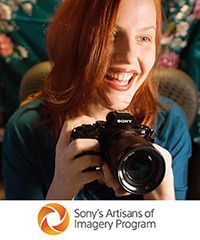
Longtime readers know how much I like doing interviews. Most of what we've published in that vein so far has been fairly technical in nature, talking about new technology with camera and lens company engineers and executives. At the bottom of it all, though, I just love talking with people, and understanding a little bit of what their lives are about.
With that as background, I've been thinking about doing more interviews, but with photographers, rather than the technical types. A bit more right-brain, if you will :-)
Thanks to Sony, I had the chance recently to chat with Vivienne Gucwa, one of their Artisans of Photography.
As an amateur photographer, I've often wondered about the process or paths taken that lead people to become successful pros. I suspect a lot of our readers might have the same curiosity, so that was a big part of my chat with Vivienne.
Vivienne's story is certainly a fascinating one, from literally not having owned a camera five years ago to a professional career as a fine art and travel photographer, with something like 2.5 million followers on social media today!
If you have questions for Vivienne, please feel free to leave them in the comments below, and we'll make sure she sees them!
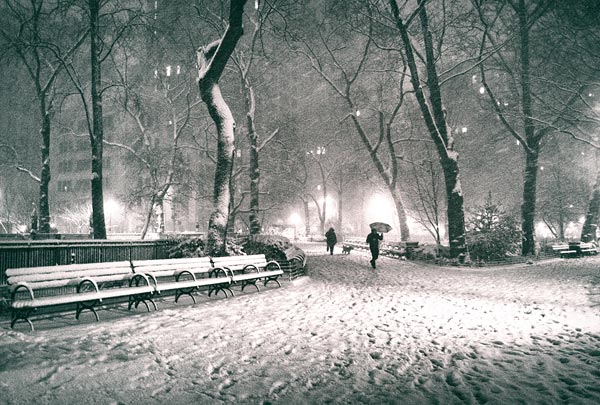
And we walk through the city like somnambulists moving through an otherworldly landscape gliding through the white remnants of dream-laden clouds towards street lights that hang over streets like stars.
Madison Square Park, Midtown Manhattan
Sony SLT-A99V | f/3.2 | 1/60 second | ISO 4000
Getting started, humble beginnings
Dave: So I'm curious, and I'm sure our readers would like to know too, what was the path that took you where you are now? How did you get started, and that sort of thing? I think we've got a lot of readers who are passionate about photography, but suspect a lot of them say, 'Well, so what do I do next? How do I take the next step?' How did it all start for you?
Vivienne: Oh wow. Okay. [Laughter] So, I have a past checkered with a lot of struggles. I moved out on my own when I was 18. Basically, my parents…it was a difficult relationship, and my parents moved away from New York City. My parents didn't want me going with them, so I stayed in New York City and spent almost a decade working seven days a week, three or four jobs.
Dave: Wow.
Vivienne: It was just to kind of keep myself in New York City. Then, at some point, I realized that I really wanted, for myself, to go back to school and finish a degree that I had started in my late teens, but kind of abandoned because I had to work. So I put myself back in school right around when I turned 30, and it was super stressful to quit working, take out loans, go back to school.
Dave: Wow, no kidding - that's a pretty scary move.
Vivienne: So to kind of cope with that stress, I would walk around a lot. I was on the Lower East Side, and I would walk around Manhattan just aimlessly. I really loved thinking a lot about what I was seeing. I've always written from the time when I was little, so I have a very vivid imagination, and I decided to buy a camera off of Amazon. At the time, because I was so broke (it was like 2009), I couldn't afford a smartphone; I couldn't afford a smartphone plan.
70,000 followers in 3 months
Vivienne: So on Amazon, I bought a camera for I think it was $79 and got it, but then it was semi-broken. [Laughter] I didn't return it because I didn't want to bother. It was just a super simple point and shoot, and I started taking photos while I went on the walks that I was going on to de-stress. At some point I had all these photos, and I asked a friend what I should do with them, because I wanted to see them aside from just the folders I had them in on my computer.
Vivienne: And my friend was like, 'Well, you should start a blog.' So I literally Googled the word 'blog', and Tumblr came up as the top search result, because Tumblr had just started getting super, super popular in 2009. So I made a blog, called it 'NY Through the Lens', and started putting my photos up there. It was just for me, to see them in some sort of pretty format, but within about three months I amassed, I think it was 70,000 followers.
Dave: Wow - seriously, 70,000 people in three months? That's crazy!
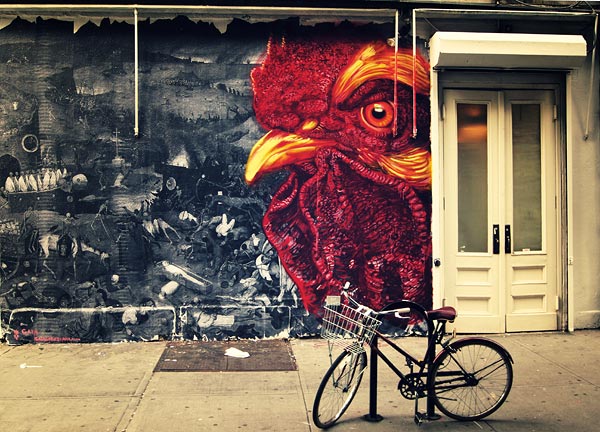
Through each scattered urban landscape, every sidewalk dream unfolds peripherally as daily adventurers traverse the city full of promise and silent giddy trepidation. Nolita, Lower Manhattan
Sony SLT-A55V | F/4 | 1/60 second | ISO 200
Maybe there's something to this whole photography thing…
Vivienne: I had all these people emailing me, and I got approached by The New York Times to do some neighborhood photo essays. All these really amazing opportunities started coming my way, which sort of made me reassess everything.
Dave: Yeah. It's like, 'Wait a minute. What am I doing here, where is this headed?'
Vivienne: So I kind of switched streams in terms of my degree. Originally I had gone back to school as pre-med because I wanted to sort of prove something to myself. Once all the photography stuff started happening, and I started having people approach me to use my work, I felt really encouraged to post more of my writing along with my photography online. I finished up my degree -- I got a degree in English [laughter] just to get out of school, and I basically just started pursuing photography as a career.
I've been a full-time photographer for the last two years, and I make my entire living off of it, but it was definitely a rocky path to get to that point. I would say that, for me, having such a big social media following definitely opened up a lot of doors. So from Tumblr, I got very encouraged to share more of my work. I was really curious about other social networks, to see what the experience would be like to share my photos and writing on other networks other than Tumblr, because Tumblr has a very specific audience. Google+ had launched, so I started sharing there. I started sharing on Facebook. Eventually I got a smartphone [laughter] and I started sharing on Instagram as well. I realized that every single network had its own very distinctive audience that connected with my work in a very different way. So that kind of encouraged me to keep sharing, and at this point, even now, I would say that like, 80% of my client work comes from people who find my work online, still.
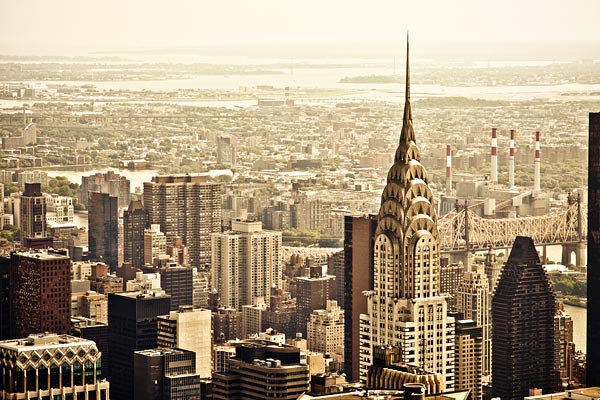
I have always been partial to late summer skyine views here in New York City. The haze that hangs over the horizon like a misty veil seems to lend a special sort of immediacy to the skyscrapers that answer themselves in the foreground.
A view of the Chrysler Building and the Queensboro Bridge, taken from
the top of the Empire State Building
Sony SLT-A77 | f/5 | 1/60 second | ISO 100
Moving up to a real (Sony) camera
Vivienne: So that definitely opened up a lot of doors. Because of that, I started speaking at various photography conferences. Another main part of the story is that I still had the semi-working point and shoot and started getting some clients, so I got a little bit of money, and I decided to upgrade to a real camera. Again, I asked a friend, 'What should I go with? Should I get a Canon, or a Nikon?' Because you know, that was the prevailing idea, you should go with one of those. My friend was like, 'Maybe you should go with Sony, because Sony is doing some really interesting stuff. And I was, 'Sure, that sounds great.'
So my very first DSLR was a Sony, and then at one of the conferences I spoke at, somebody from Sony was there. We sort of started a relationship, because back then very few photographers were shooting with Sony professionally. Now, of course, it's changed, but we developed a relationship, and then as of this year I'm one of nine sponsored photographers with Sony. So I would say it's been a combination of just sharing my work online and taking a lot of different opportunities that came my way. In terms of the public speaking, it was not being scared off by that, but doing it, and making a lot of really nice connections and relationships with people in the industry, and seeing where everything was.
Dave: That's really so amazing. You basically started out five years ago with a semi-working point and shoot, never having been a photographer before, and now you're a Sony Artisan, and you're traveling all over the world. You've got big-time paying clients; that's really pretty amazing. And you said, 2.5 million followers. That's unbelievable.
Vivienne: Yeah, and my book just came out. I know, honestly it still feels really surreal. Like, even when I speak, or I do interviews, I feel like I'm telling somebody else's story. [Laughter] But yeah, it's been quite a journey, definitely.
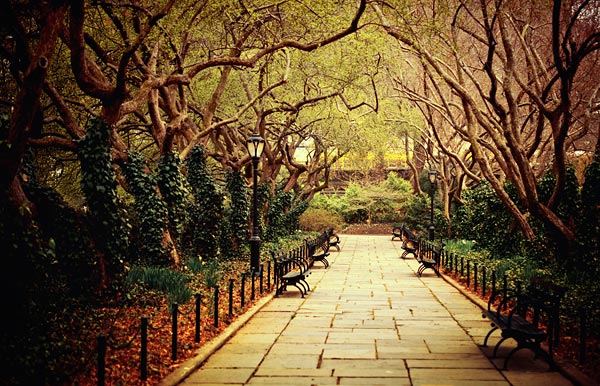
Central Park, Manhattan Sony SLT-A99V | f/3.5 | 1/40 second | ISO 1250
How to win friends and influence people (apologies to Dale Carnegie)
Dave: I definitely want to talk about your book in just a bit, but I wanted to go back to the beginning again first. You said you started on Tumblr, and within three months you had 70,000 followers. How did all those people connect with you? Was it kind of word of mouth, and other Tumblr bloggers posting links? How did those people find you?
Vivienne: Back when I started on Tumblr, and even now, it's a very viral network. So people will re-blog your posts if they really like them, and then that kind of gets re-blogged by other people, and it can really snowball. So I think it was a combination of that I've always written with my photos, and that made me stand out a little bit on Tumblr because a lot of people don't post original content on Tumblr, and don't write a lot.
Dave: Yeah, it tends to be a ton of images and very few words. You're right, that's one thing that's really unique about your Tumblr blog, is that you're a story-teller, and you can kind of convey a mood or emotion associated with a photo. I think it really adds a lot to the photography.
Vivienne: Thank you. I agree. I think that might have been a component that spurred that popularity early on. Also you know, Tumblr itself, as an entity, does take notice of content that they like, and they'll showcase it at certain points. So very early on I had several of my photos showcased by Tumblr, and then that got picked up by other entities who were also on Tumblr at the time, and who were also just sort of navigating this new world. For instance, Newsweek Online had just started on Tumblr, and they re-posted one of my photos, and and Kate Spade, like that, and that really sort of snowballed. So a lot of people found me that way, and then started following my Tumblr.
Dave: Yeah. It sounds a little bit like part of the message is to just follow your passion, and then get it out there so that people have an opportunity to connect with it. I mean, for you it was very personal; it started out of this stress relief, aimless walking, and then you're kind of taking pictures, a little bit like occupational therapy, to de-stress from school.
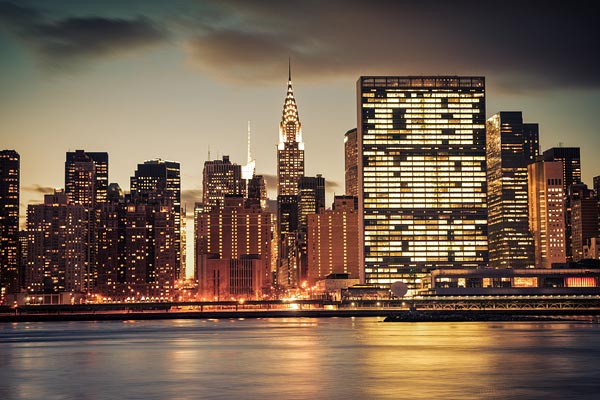
There is a heady essence of myth that permeates the in-between times of the day. It seems to seep out especially in the evening just after the sun has reached the horizon, when the air is thick with legend. One of my favorite activities is waiting for the night to fall while experiencing the deep inhale and exhale of the city. Light spills out from the buildings and pours itself onto the surface of the water and the sky, while the blue of the day’s sky melts into the night’s palm.
The Chrysler Building and U.N. Building taken from Roosevelt Island
Sony SLT-A99V | f/4 | 16 seconds | ISO 50
Would this have worked anywhere other than New York?
Dave: It seems like so much of what you do is very intimately associated with New York, and of course your initial blog (still your blog), was 'NY Through the Lens'. Do you think you could have done this somewhere else, or is a lot of it really particular to New York and that environment, and the richness of it?
Vivienne: I definitely would have done this if I lived elsewhere. Do I think that a lot of the early opportunities I got would have come as quickly as they did? I don't know. I mean, maybe that's up for debate, but I think I was definitely in the right place at the right time. When The New York Times contacted me to do the little photo essays that I did early on, that was based on the neighborhood of the East Village. That was for an East Village hyper-local news blog that they had. So I think that that was definitely related to the location, but I think for me, all my photography is very tied into all the influences that have informed my work.
So I'm really heavily influenced by art, art history, cinema, other fantastical representations of New York. I've always had this sort of interesting take on New York that I used to try to write about for many, many years, but it felt like an incomplete form of expression. So once I started doing photography and found out that I really loved it, it sort of felt like the perfect marriage, to be able to marry the words with the photos, and kind of show my vision of New York that way. So for me, New York is completely tied into nostalgia, and memory, and all of the things that go into how I felt about New York when I was little, growing up here.
So it's difficult to say. I mean, if I had been anywhere else in the world, I probably would have been doing the same thing, and maybe that would have been tied into my nostalgic feelings of that place. I think New York definitely does have a certain appeal to people, though. New York is a city that represents a whole host of positive and negative things.
Dave: Yeah. It's really iconic in a lot of ways, in terms of the city itself, and the emotions associated with it. I mean, you might have done the same thing, but if you'd been in Tallahassee or somewhere… I mean, no aspersions on Tallahassee, but it might not have gotten you to where you are; there might not have been as much opportunity to connect with other people over it.
Vivienne: Yeah.
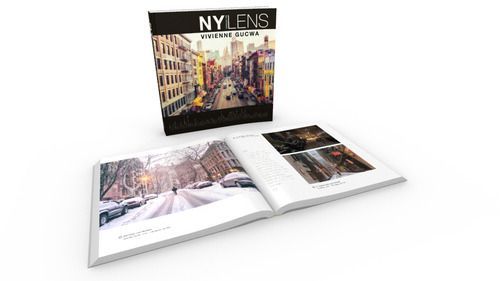
Breaking into print, meeting a publisher
Dave: That's really interesting. So you mentioned that you just had this book come out. It has kind of an interesting story behind it, tell us how that happened.
Vivienne: Well, the book is named after my blog, which is 'NY Through the Lens'. Basically I… My whole timeline is so screwy right now. It doesn't feel like all of this happened in a year, but it did! [Laughter] So last autumn, I spoke at PhotoPlus Expo in New York, and at the end of my first presentation somebody approached me and asked me if I'd ever been interested in publishing my work. Of course, I'm a very cynical New Yorker, [laughter].
Dave: You said, 'Yeah, right. No, I won't give you my phone number.'
Vivienne: I'm like, 'Sure, I'll take your card, whatever.' I then relayed it to another friend who was there, and my friend asked, 'Oh, was this person named…?' And she named the person who I talked to, and she was like, 'Wow, no. I actually published a book with them. That's the real deal.' [Laughter] And so we met, and we started talking about doing a book, and I definitely got very, very lucky with my publisher because they gave me full creative control.
Dave: Wow.
Vivienne: In terms of what I wanted the book layout to be, what I wanted to include in the book. So the book is basically a collection of my New York photos, and I included my writing with it as well. So it was a really interesting process, actually, to write and compile all of my work for a book, as opposed to the blog. It was interesting to sort of look at everything as its own collection, and think about how to cohesively make it work together in one entity. Something that people would be holding in their hands, you know?
Dave: Had the person that approached you been following your blog previously? Or did he or she just see you at PhotoPlus?
Vivienne: No, they just saw me, and they listened to my whole presentation, which at the time I think I was presenting about just my style of photography and doing what I do. So yeah, it was just this really crazy once in a lifetime sort of experience. But yeah, it was great. So I took the whole first part of this year to do the book, and then it went into editing, and then it just released in November everywhere.
Dave: Wow. So it was just a little over a year then, from the first contact to the book coming out.
Vivienne: Yeah. We could have taken longer, but I really, really wanted to put the book out for this holiday season.
Dave: Yeah.
Vivienne: Because a lot of my readers have asked me for a few years, you know, 'When are you going to do a book? When are you going to do a book?' And I toyed around with the idea of self-publishing, but I didn't really want to go that route. I know other people who've self-published, and it's been really challenging for them. So I feel like I got super lucky in terms of getting a traditional book deal.
Dave: So the actual publisher, I'm looking at a copy here, is it Iilex Press that was the publisher? But then it says Print Books, an imprint of F&W.
Vivienne: Ilex Press is the publisher. They're based in Britain. They were just actually purchased by Hachette, so they're now known as Octopus Books.
Dave: Oh, everybody got purchased by Hachette, it seems :-)
Vivienne: But the rights for the US and Canada distribution are F&W Media, and it reads that way on the US copy.
Dave: Oh, I see. Well, it's a great position for an author with a new book out, to have two and a half million people that are already following you.
Vivienne: Yeah.
Dave: I would guess it's selling well. Actually, as soon as I found out about you, I went on Amazon, ordered a copy, and then the next day I wanted to order another copy for IR, and they were out of stock!
Vivienne: Yeah, it sold out twice on Amazon, which is crazy.
Dave: Jeez…
Vivienne: Yeah. It's been a really interesting process because I've gotten some really nice press so far. I can't actually ask for better press. It was featured in The Guardian, and it's on weather.com...
Dave: Weather.com, wow.
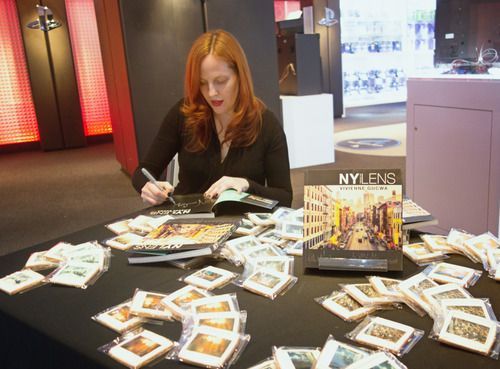
Vivienne: Last week Wired Magazine threw a party where I literally gave out 250 copies of my book and signed them for all of their guests. So I've had really beautiful press, and it's been a really interesting experience to go from navigating just the online world, which can feel a bit like a bubble sometimes, to looking at the world of traditional press, traditional publishing, and now navigating that world as well.
Building the book
Dave: Yeah. So what's the publishing process like? I bet some of our readers have wondered about that. What was it like to go from digital files to the finished book?
Vivienne: It was a lot of work. [Laughter] Initially I wrote out 30,000 words, which for a photo book is quite a lot, considering that it's a table top book. I knew that, obviously, a lot of the words would be pulled because of the format of the book, but that was an interesting process, to go through a lot of my creative writing from the blog, and figure out what worked, what didn't, what was cohesive. You know, things that I repeated all the time, I had to really, really examine my writing.
Dave: Yeah.
Vivienne: And then the book has around 300 images, so I did work on the layout. I did the work on an initial layout, what I wanted, my dream layout. Then I submitted it, and once I submitted it, it went into the editing process for about two months. They did a great job. I was concerned initially; I do a lot of printing of my own work for clients here in New York City, so I know the headaches that come with printing, and getting perfect color, and beautiful results. I was initially really, really, really scared about that whole process with the book. I was like, 'Oh my god, how is everything going to end up looking good? What if I'm not happy with it?' But they did an exceptional job with the color, the presentation, and everything. So honestly, I couldn't be happier.
Dave: So during that two month process, there was back and forth during that time, or was kind of like they went away?
Vivienne: Yeah.
Dave: So they were coming back to you and asking you, 'How about this? How about that?'
Vivienne: Yeah.
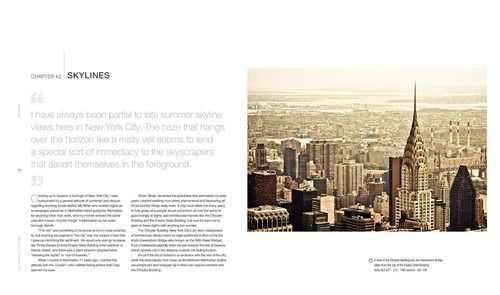
Layout in Lightroom?
Dave: But you actually laid out the whole book initially then, on the desktop. Did you do it in InDesign, or something like that?
Vivienne: I had all these aspirations of doing it in InDesign, and in the end I ended up using Lightroom.
Dave: Really, Lightroom? Huh.
Vivienne: Yeah. I just…I'm trying to remember what I did. Lightroom has its own sort of book layout function, and I just ended up doing that, and it turned out really, really good. It was a super easy process once I stopped fighting [laughter] with everything else.
Dave: Yeah, that's really interesting. Lightroom was already a tool you were intimately familiar with, so you didn't have to come up a big learning curve with InDesign or something.
Vivienne: No, no.
Dave: And your job wasn't so much to work on the fine details of the typography, and kerning all the letters, and that kind of thing anyway.
Vivienne: No, that was all them.
Dave: Right, so you could just kind of create the structure, and then they could tweak it and fill in the blanks.
Vivienne: Yep.
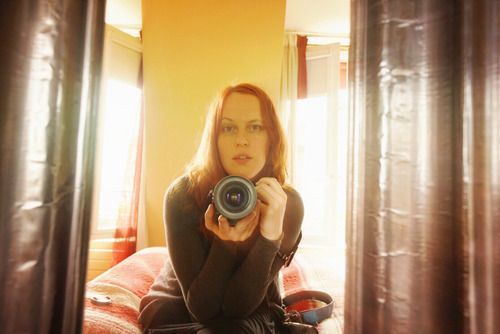
More Vivienne to come, stay tuned!
Part two of this interview is up and ready for your reading (and viewing) pleasure. In it, we talk with Vivienne about her approach to photography, talk about her current work and clients, her favorite photos, and the gear she's shooting with today!
Support Vivienne, buy her book!
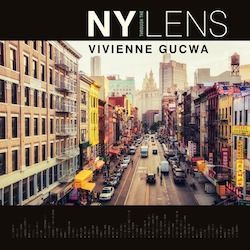
Meanwhile, you're really got to check out Vivienne's book! She calls her style "fantastical," and I think that's a pretty good description; there's an air of fantasy about a lot of her pictures, a slight otherworldliness. Or perhaps it's that so many of her shots seem iconic in nature, possibly because New York itself is that way. They're not just shots of a city at night or in the snow, they're photos of The City somehow, something timeless and invoking a feeling of fantasy. I love her narrative, too; it adds so much depth to the photos, and a very personal sense of the experience. However you describe her work, whether you're a lover of New York, The City or just great photos in general, Vivienne's book is well worth the price! (Really, I wouldn't say it if it weren't so.)
You can find Vivienne's book on Amazon. Note that these links include Vivienne's own affiliate code for Amazon, so your purchases through it will help support her and her art more than just a random purchase elsewhere would :-)
Stay tuned for Part II of this interview, hopefully to come early next week!
- And thanks to Vivienne, for sharing so freely from her experience. I love conversations like this!
Vivienne elsewhere
Also be sure to check out Vivienne's NYC blog NY Through the Lens, or her travel blog Traveling Lens. You can also purchase prints and wall art of both her New York City and Travel Photos, to have for your own!
About this article
This piece is a bit of a trial run, to see how both our readers and Vivienne's fans respond to it, and whether Sony might be interested in sponsoring stories like this going forward. Please let me know your thoughts about this sort of interview piece in general and this one in particular in the comments section below. This piece wasn't sponsored, but it and the second half of the interview will typical of the kind of branding that you'd see in a sponsored post of this kind. The hope is for the manufacturer to get good exposure for their brand, through the experience of a pro photographer who uses their equipment, without beating readers over the head with "Sony is the best! Sony is the best!" every other paragraph. Let me know what you think!